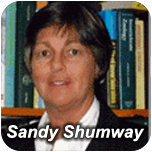Sandra Shumway
(Ph.D., D.Sc. University College of North Wales) Research Professor of Marine Sciences, emeritus
Educational Experience
B.S. (Summa Cum Laude) Southampton College, Long Island University 1974 (Marine Science)
Ph.D. University College of North Wales 1976 (Marine Science)
D.Sc. University College of North Wales 1992 (Marine Science)
Editor, Journal of Shellfish Research
(www.shellfish.org)
Editor, Journal of Experimental Marine Biology and Ecology
(www.elsevier.com)
Founder and co-Editor, Harmful Algae
(www.elsevier.com)
Research interests
Physiological ecology of marine invertebrates, shellfish biology, aquaculture, toxic algae
Current research is focused on the impacts of harmful algal species on shellfish and aquaculture
Academic Honors
Marshall Scholar; William Evans Visiting Professor, University of Otago, NZ; American Men and Women of Science; Long Island University Trustees Award for Lifetime Scholarly Achievement; Education Service Award, Science Council of New York City; David Newton Award for Excellence in Teaching, Long Island University; Distinguished Lecturer, University of Maryland ; Long Island University Trustees Award for Scholarly Achievement ; Aldo Leopold Fellow (http://leopoldleadership.stanford.edu/); National Shellfisheries Association Honored Life Member (2001)
Other
Past-President, National Shellfisheries Association; currently President-elect
Research Projects
ECOHAB: Assessment of the potential for introduction of harmful algal bloom (HAB) species via shellfish transport – Environmental Protection Agency
Oceanography Students
Eric Heupel – Ph.D. Student
Oceanography Alumni
Hélène Hegaret – Ph.D. 2008
John Natale – M.Sc. 2014
Publications
Shumway, S.E., T.L. Cucci, R.C. Newell and C.M. Yentsch – 1985. Particle selection, ingestion and adsorption in filter feeding bivalves. J. Exp. Mar. Biol. Ecol. 91: 77-92.
Shumway, S.E. and T.L. Cucci – 1987. The effects of the toxic dinoflagellate Protogonyaulax tamarensis on the feeding and behavior of bivalve molluscs. Aquat. Toxic. 10: 9-27.
Gainey, L. and S.E. Shumway – 1988. Physiological effects of Protogonyaulax tamarensis on cardiac activity in bivalve molluscs. Comp. Biochem. Physiol. 91C: 159-164.
Newell, C.R., S.E. Shumway, T.L. Cucci and R. Selvin – 1989. The effects of natural seston particle size and type on feeding rates, feeding selectivity and food resource availability for the mussel, Mytilus edulis Linnaeus, 1758 at bottom culture sites in Maine. J. Shellfish Res. 8:187-196.
Shumway, S.E. – 1990. A review of the effects of algal blooms on shellfish and aquaculture. J. World Aquac. Soc. 21:65-104.
Shumway, S.E., J. Barter and S. Sherman-Caswell – 1990. Auditing the impact of toxic algal blooms on oysters. Environ. Auditor 2:41-56.
Cembella, A.D., S.E. Shumway and R. Larocque – 1994. Sequestering and putative biotransformation of paralytic shellfish toxins by the sea scallop, Placopecten magellanicus (Gmelin, 1791): seasonal and spatial scales in natural populations. J. Exp. Mar. Biol. Ecol. 180: 1-22.
Shumway S.E., S.A. Sherman, A.D. Cembella and R. Selvin – 1994. Accumulation of paralytic shellfish toxins by Atlantic surfclams, Spisula solidissima (Dillwyn, 1817) from the Gulf of Maine: Seasonal changes, distribution between tissues and notes on feeding habits. Natural Toxins 2:236-251.
Shumway, S.E. – 1995. Phycotoxin-related shellfish poisoning: bivalve molluscs are not the only vectors. Reviews in Fisheries Science 3:1-31.
Smolowitz, R. and S.E. Shumway – 1997. Possible cytotoxic effects of the dinoflagellate, Gyrodinium aureolum on juvenile bivalve molluscs. Aquaculture International 5: 291-300.
Boesch, D.F., D.M. Anderson, R.A. Horner, S.E. Shumway, P.A. Tester, T.E. Whitledge – 1997. Harmful Algal Blooms in Coastal Waters: Options for Prevention, Control and Mitigation. NOAA Coastal Ocean Program Decision Analysis Series NO. 10. NOAA 46pp. + appendix.
Ward, J.E., J.S. Levinton, S.E. Shumway and T.L. Cucci – 1997. Direct identification of the locus of particle selection in a bivalve mollusk. Nature 390: 131-132.
Ward, J.E., J.S. Levinton, S.E. Shumway and T.L. Cucci – 1998. Particle sorting in bivalves: In vivo determination of the pallial organs of selection. Marine Biology 131(2): 283-292.
Bricelj, V.M. and S.E. Shumway – 1998. A review of paralytic shellfish poisoning toxins in bivalve molluscs: occurrence and transfer kinetics. Reviews in Fisheries Science 6:315-383
Grizzle,R., S.E. Shumway and V.M. Bricelj – 2001. Physiology and Bioenergetics of Mercenaria mercenaria. pp. 305-382 In: Kraeuter, J.N. and M. Castagna (eds) The Hardclam, Mercenaria mercenaria, . Elsevier Science Publishers. 751pp
Parsons, G. Jay, S.E. Shumway, S. Kuenstner and A. Gryska – 2002. Polyculture of sea scallops (Placopecten magellanicus) suspended from salmon cages. In Press Aquaculture International
Levinton, J.S., J.E Ward and S.E. Shumway – 2002. Responses of oysters and mussels to aging and chemical composition of kelp detrital particles. Marine Biology 141:367-376
Springer, J.T., S.E. Shumway J. Burkholder and H. Glasgow – 2002. Impacts of Pfiesteria piscicida on the eastern oyster, Crassostrea virginica. In press Marine Ecology Progress Series
Shumway, S.E. (editor) 1991. Scallops: Biology, Ecology and Aquaculture. Elsevier. 1068pp.
Shumway, S.E. and G.J. Parsons (editors) 2003. Scallops: Biology, Ecology andAquaculture. Elsevier. 2nd Edition. In Preparation (publication expected 2003).

| sandra.shumway@uconn.edu | |
| Phone | 860-405-9282 |
| Fax | 860-405-9153 |